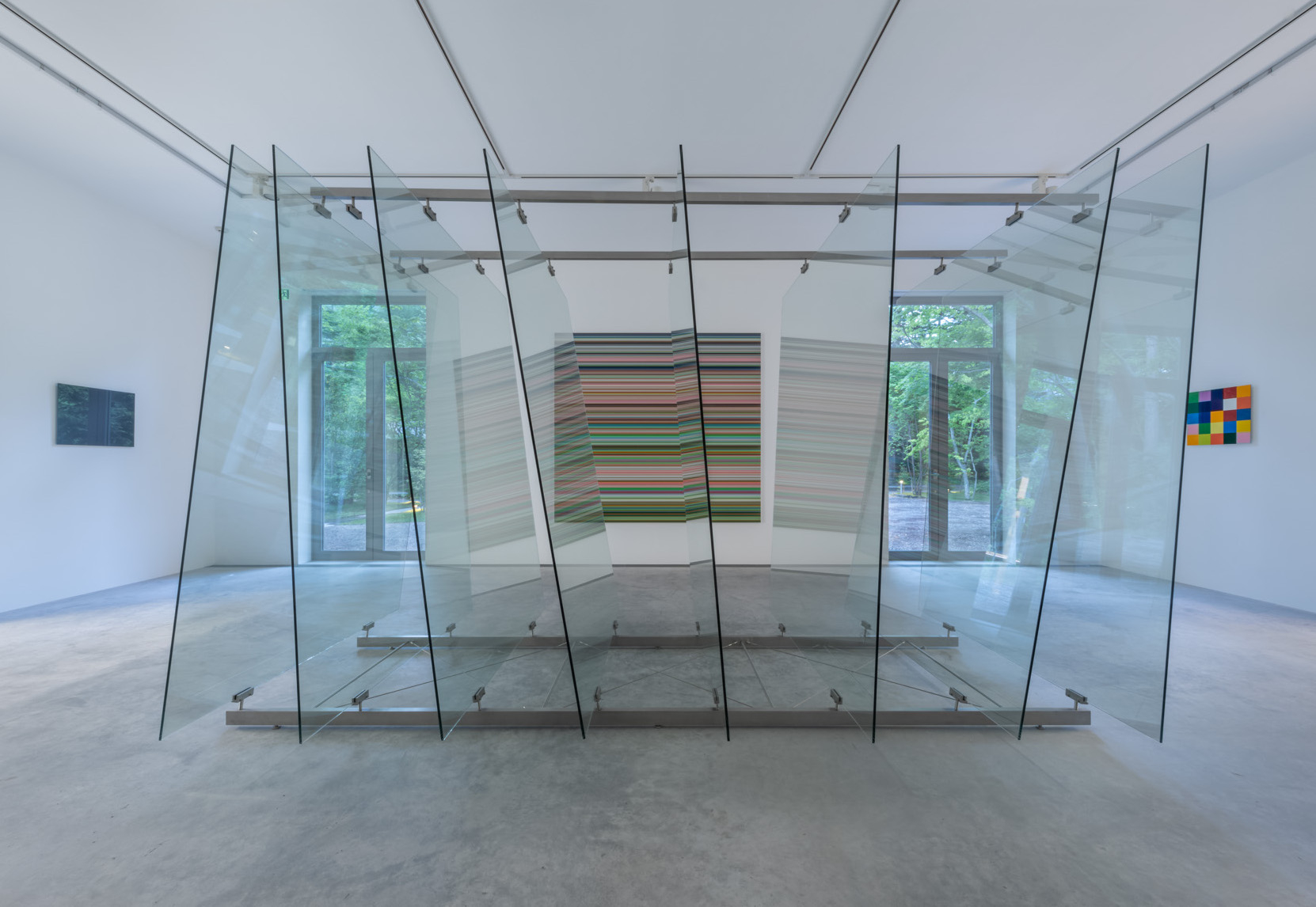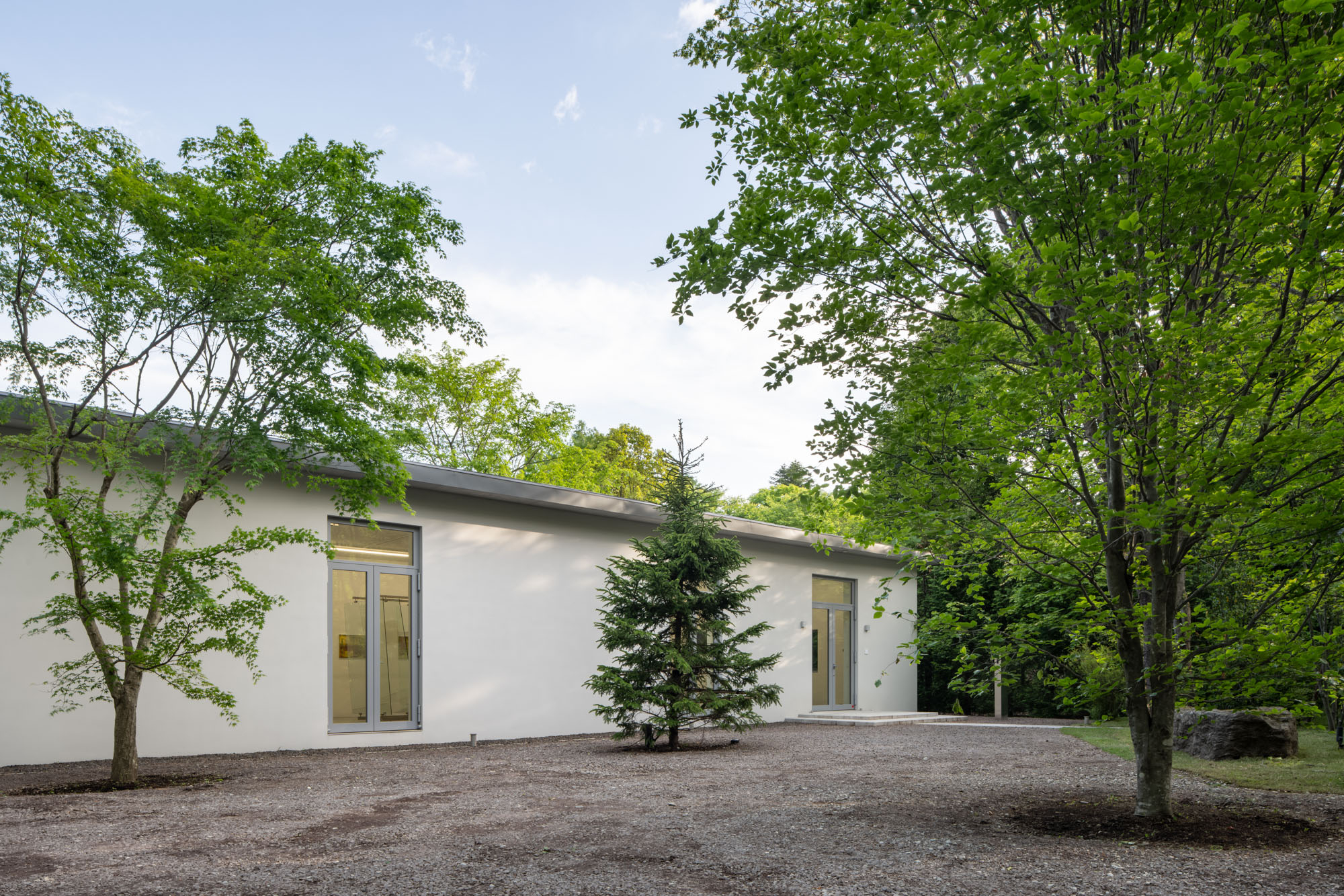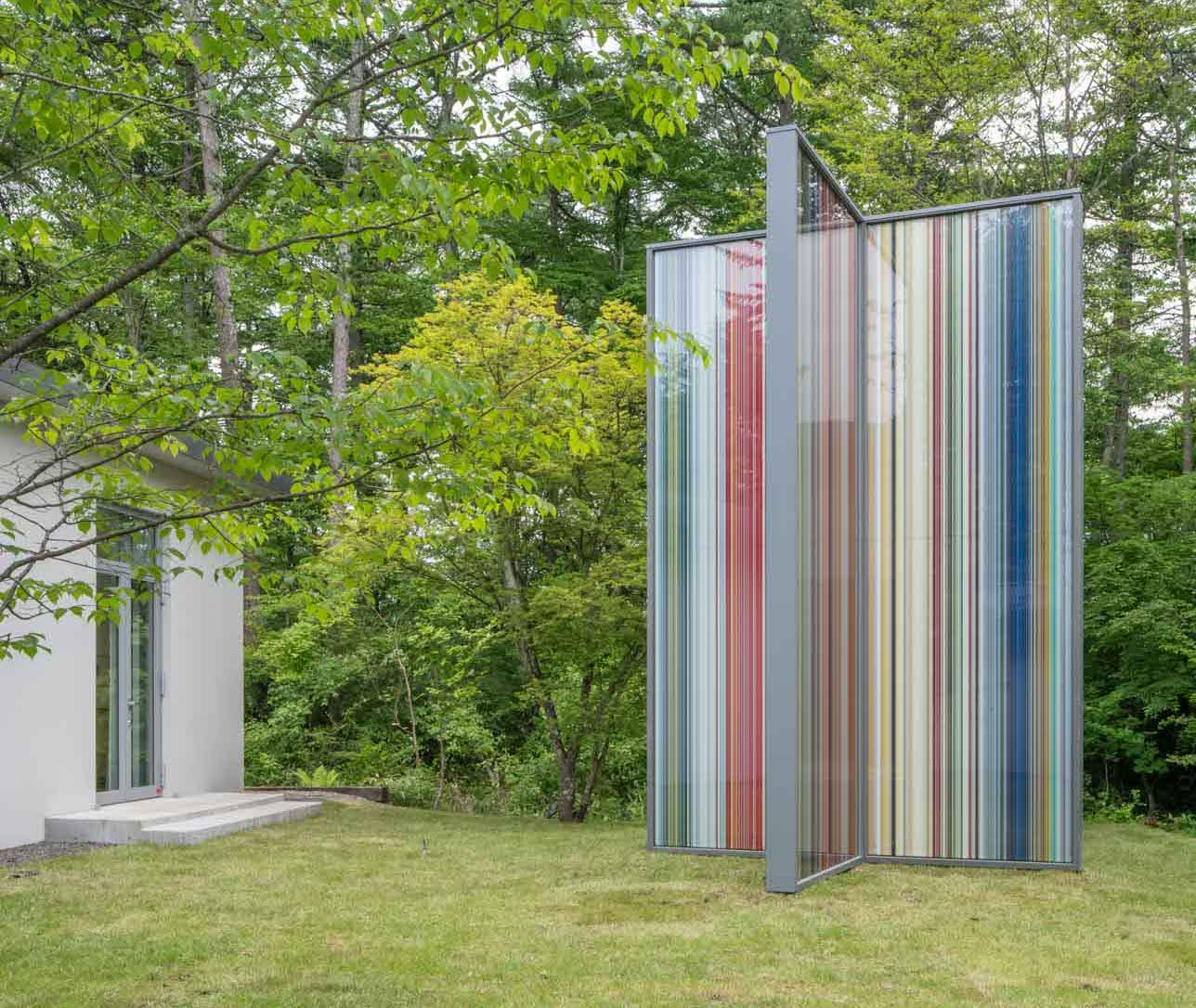Cultural Currency 15: Strip Sculpture Karuizawa
Gravestones as monuments
By Shimizu Minoru
2023.08.30

photo: ToLoLo studio
Wako Works of Art, which over the past 30 years has contributed to the reception of Gerhard Richter in Japan as one of the primary galleries showing his work, has opened Richter Raum, a small, specialty art museum in Karuizawa where works by Richter are permanently installed. A literal English translation of the museum’s name would be “Richter Room,” but because the meaning of the German word raum is closer to “space” than “room,” and because it can also mean “outer space,” it would be more accurate to call Richter Raum a space for Richter’s artworks, or a microcosm of Richter’s art.
 Richter’s relationship with Japan goes back to 1968, shortly after his debut. At a time when he was still unknown internationally, the first group exhibition he participated in outside Europe was at the Nagaoka Contemporary Art Museum in Niigata. This was a private museum built to house a collection put together by Komagata Jukichi, a businessman and banker from Nagaoka, and one of the first art museums in Japan to use the word “contemporary” in its name (it closed in 1979). To coincide with its opening in 1964, it organized an international contemporary art prize that was ahead of its time, and eight Japanese artists and seven West German artists were invited to take part in the fifth (and final) exhibition in 1968. The West German artists were selected by Hariu Ichiro, whose keen discernment in selecting Richter at that time is astonishing.1 It was the following year, 1969, when Richter won a Theodoron Award and participated in a group exhibition in New York together with the other awardees (at the Guggenheim Museum, May 24–June 29), but the same year he was already taking part in “Contemporary Art: Dialogue between the East and the West” (June 12–August 17, 1969) at the National Museum of Modern Art, Tokyo.
From then until his most recent exhibition (2022), for Richter, Japan has continued to be one of the places where he first unveils new initiatives. The simultaneous exhibition of paintings and objects at the Nagaoka Contemporary Art Museum, the exhibition together of Strip works and glass works, the installation on Toyoshima (the last and largest of his glass works)2 , the new Abstract Paintings following Birkenau, and the centerpiece at Richter Raum, the 5-meter-tall outdoor object Strip Sculpture Karuizawa—not to mention a private (Japanese) collector purchasing one of the Standing Glass Panes straightaway when the work was shown here—were all firsts that took place in Japan.
Richter’s relationship with Japan goes back to 1968, shortly after his debut. At a time when he was still unknown internationally, the first group exhibition he participated in outside Europe was at the Nagaoka Contemporary Art Museum in Niigata. This was a private museum built to house a collection put together by Komagata Jukichi, a businessman and banker from Nagaoka, and one of the first art museums in Japan to use the word “contemporary” in its name (it closed in 1979). To coincide with its opening in 1964, it organized an international contemporary art prize that was ahead of its time, and eight Japanese artists and seven West German artists were invited to take part in the fifth (and final) exhibition in 1968. The West German artists were selected by Hariu Ichiro, whose keen discernment in selecting Richter at that time is astonishing.1 It was the following year, 1969, when Richter won a Theodoron Award and participated in a group exhibition in New York together with the other awardees (at the Guggenheim Museum, May 24–June 29), but the same year he was already taking part in “Contemporary Art: Dialogue between the East and the West” (June 12–August 17, 1969) at the National Museum of Modern Art, Tokyo.
From then until his most recent exhibition (2022), for Richter, Japan has continued to be one of the places where he first unveils new initiatives. The simultaneous exhibition of paintings and objects at the Nagaoka Contemporary Art Museum, the exhibition together of Strip works and glass works, the installation on Toyoshima (the last and largest of his glass works)2 , the new Abstract Paintings following Birkenau, and the centerpiece at Richter Raum, the 5-meter-tall outdoor object Strip Sculpture Karuizawa—not to mention a private (Japanese) collector purchasing one of the Standing Glass Panes straightaway when the work was shown here—were all firsts that took place in Japan.
 For details of the works on display at Richter Raum and of the newly installed outdoor monument, readers can refer to the commercially available pamphlet. However, I would like to add to the commentary by Dieter Schwarz, which he wrote before viewing the works as they appear following their installation at Karuizawa, based on my own actual viewing experience. The Strip series represents the most refined form of the second phase of Abstract Paintings and consists of images produced by repeatedly mirroring and dividing a single Abstract Painting first in two, then four, then eight, and so on exponentially to produce extremely thin vertical strips (Richter used the equivalent of 12 mirrors to produce 4096 strips) that were then stretched horizontally. In other words, within each strip there are invisible mirrors, so to speak, lined up in a row. Formally, all of Richter’s works involve reducing painting to its ultimate essence as layers, and because Standing Glass Panes is a series of works in which transparent glass sheets serving as layers stand in rows like gravestones, the Strip paintings and glass sculptures could be called sister works—the climax of the second phase of Abstract Painting.3
The Strip works are in a sense compressed Abstract Paintings, and when viewed indoors, the exposed strips of color uncovered by glass have a powerful absorptive effect on the viewer. Strip Sculpture is a series (to date, three have been created) in which these works are refashioned as vertical sculptures, and as the first of the series to be installed outdoors, Strip Sculpture Karuizawa is covered in protective glass, the same glass of the highest quality available in Japan that was used in the glass work on Toyoshima. In other words, Strip and Richter’s glass sculptures are monuments in which mirrors and glass are combined.
The other monument, Toyoshima’s 14 Standing Panes of Glass “dedicated to futility,” expresses with 14 sheets of glass the climax of Richter’s art, as if emulating the 14 stations (Stations of the Cross). In Richter’s imagination, it is a device on an uninhabited island in the Far East that continually transforms into nothing but layers the surrounding natural environment, which changes by the day and by the moment unseen by anyone (ie, futilely). The Strip Sculpture works, which form crosses when viewed from above, are also in the end kinds of gravestones.
The effect of the by no means “futile” gravestone installed in the garden at Richter Raum in Karuizawa, which is visited by large numbers of people, is mysterious. For a start, because it naturally reflects the viewer and the surrounding scenery, the work as a whole takes on a feeling of transparency while depth arises between the strips of color. This enhances the absorptive effect, while the reflections also have the effect of repelling the viewer. The conflict between these two contradictory effects continually changes depending on the weather, depending on the colors of the sky and of the trees, and depending on the hues of each part of the work.
It probably goes without saying that Richter Raum has realized a certain end point as far as the gallery is concerned, but it is more than just a place where Richter’s works are permanently installed. As people who have seen the Corinna Belz documentary Gerhard Richter Painting (2011) will realize, many features of the design of Richter Raum, from the tall, narrow doorways and square windows to the wooded setting, were freely modelled on Richter’s studio. Visitors can view the works in a space that is noticeably more personal and intimate than an art museum.
For details of the works on display at Richter Raum and of the newly installed outdoor monument, readers can refer to the commercially available pamphlet. However, I would like to add to the commentary by Dieter Schwarz, which he wrote before viewing the works as they appear following their installation at Karuizawa, based on my own actual viewing experience. The Strip series represents the most refined form of the second phase of Abstract Paintings and consists of images produced by repeatedly mirroring and dividing a single Abstract Painting first in two, then four, then eight, and so on exponentially to produce extremely thin vertical strips (Richter used the equivalent of 12 mirrors to produce 4096 strips) that were then stretched horizontally. In other words, within each strip there are invisible mirrors, so to speak, lined up in a row. Formally, all of Richter’s works involve reducing painting to its ultimate essence as layers, and because Standing Glass Panes is a series of works in which transparent glass sheets serving as layers stand in rows like gravestones, the Strip paintings and glass sculptures could be called sister works—the climax of the second phase of Abstract Painting.3
The Strip works are in a sense compressed Abstract Paintings, and when viewed indoors, the exposed strips of color uncovered by glass have a powerful absorptive effect on the viewer. Strip Sculpture is a series (to date, three have been created) in which these works are refashioned as vertical sculptures, and as the first of the series to be installed outdoors, Strip Sculpture Karuizawa is covered in protective glass, the same glass of the highest quality available in Japan that was used in the glass work on Toyoshima. In other words, Strip and Richter’s glass sculptures are monuments in which mirrors and glass are combined.
The other monument, Toyoshima’s 14 Standing Panes of Glass “dedicated to futility,” expresses with 14 sheets of glass the climax of Richter’s art, as if emulating the 14 stations (Stations of the Cross). In Richter’s imagination, it is a device on an uninhabited island in the Far East that continually transforms into nothing but layers the surrounding natural environment, which changes by the day and by the moment unseen by anyone (ie, futilely). The Strip Sculpture works, which form crosses when viewed from above, are also in the end kinds of gravestones.
The effect of the by no means “futile” gravestone installed in the garden at Richter Raum in Karuizawa, which is visited by large numbers of people, is mysterious. For a start, because it naturally reflects the viewer and the surrounding scenery, the work as a whole takes on a feeling of transparency while depth arises between the strips of color. This enhances the absorptive effect, while the reflections also have the effect of repelling the viewer. The conflict between these two contradictory effects continually changes depending on the weather, depending on the colors of the sky and of the trees, and depending on the hues of each part of the work.
It probably goes without saying that Richter Raum has realized a certain end point as far as the gallery is concerned, but it is more than just a place where Richter’s works are permanently installed. As people who have seen the Corinna Belz documentary Gerhard Richter Painting (2011) will realize, many features of the design of Richter Raum, from the tall, narrow doorways and square windows to the wooded setting, were freely modelled on Richter’s studio. Visitors can view the works in a space that is noticeably more personal and intimate than an art museum.
——————————–
1 Richter showed the 1968 painting Wellblech (CR193) and the object Röhren (CR59). The catalogue published when the Niigata Prefectural Museum of Modern Art held the “Nagaoka Contemporary Art Museum Award Retrospective” in 2002 contains a photographic record of this fifth exhibition. 2 Installed on its own in a building that Richter himself designed on the island of Toyoshima in Ehime, 14 Panes of Glass for Toyoshima, dedicated to futility continues to reflect daily the beautiful scenery of the Setouchi region unobserved by humans. For access details and opening hours, see https://www.kamijima.info/en/#toyoshima https://goo.gl/maps/itKV98DthRHuzaPU6 3 This was clearly demonstrated at the 2011 solo exhibition at Marian Goodman Gallery (Paris) where works from the Strip series and a glass sculpture were presented together.
——————————–
Shimizu Minoru
Critic. Professor, Doshisha University.
Richter Raum (Advance reservations are required.)
https://www.richterraum.jp/

©︎ 2023 Gerhard Richter / Wako Works of Art
photo: ToLoLo studio

©︎ 2023 Gerhard Richter / Wako Works of Art
photo: ToLoLo studio
——————————–
1 Richter showed the 1968 painting Wellblech (CR193) and the object Röhren (CR59). The catalogue published when the Niigata Prefectural Museum of Modern Art held the “Nagaoka Contemporary Art Museum Award Retrospective” in 2002 contains a photographic record of this fifth exhibition. 2 Installed on its own in a building that Richter himself designed on the island of Toyoshima in Ehime, 14 Panes of Glass for Toyoshima, dedicated to futility continues to reflect daily the beautiful scenery of the Setouchi region unobserved by humans. For access details and opening hours, see https://www.kamijima.info/en/#toyoshima https://goo.gl/maps/itKV98DthRHuzaPU6 3 This was clearly demonstrated at the 2011 solo exhibition at Marian Goodman Gallery (Paris) where works from the Strip series and a glass sculpture were presented together.
——————————–
Shimizu Minoru
Critic. Professor, Doshisha University.
Richter Raum (Advance reservations are required.)
https://www.richterraum.jp/